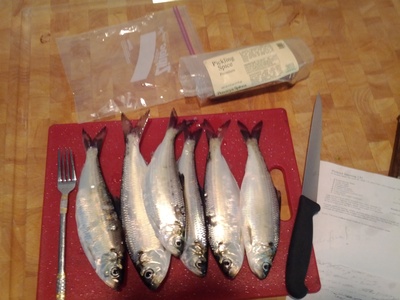Today I looked into some questions regarding herring in the Hudson River.
Is it legal to catch herring for bait just below the Troy dam?
Yes. Possession of the proper fishing license entitles an angler to collect alewives and blueback herring for personal use in hook-and-line fishing only (sale prohibited) by angling, seine or cast nets. Regulations vary by location. Transportation of herring for use as bait is prohibited except along transportation corridors outlined and mapped in the regulations guide. The area around the Hudson River below the Troy dam is one such corridor.
Is it legal to catch herring for eating? When is open season? What is the limit?
Yes, herring can be caught any time, with no limit in the Hudson River upstream to Troy Dam, and some parts of the Mohawk River, and also in all tributaries from river upstream to first barrier impassable by fish. Anglers must enroll in the Recreational Marine Fishing Registry. Once these species are transported away from the water body, they may not be transported back to any water body for use as bait.
Is it safe to eat herring from the Hudson? What are the recommended restrictions on eating them?
If a person were to eat Hudson River fish at a rate greater than the recommended one meal-per-month, they could expect to eventually end up with twice as much mercury in their system as a person who did not eat these fish. The person would still be well within the limits that the EPA recommends as "safe", although I don't have confidence that "safe" actually means "safe". I conclude that as a grown man, eating a few Hudson River pickled herring should be ok (with some warranted hesitation and disclaimers). Women of childbearing age and children under 15 should avoid them.
Unanswered Questions:
I was surprised to read that the upper Hudson is the worst area to eat fish, and that the lower Hudson contains healthier fish. I expected that the further downstream you get, the worse the water would be because there would be more factories contributing to the pollution, but apparently this is not the case. It makes sense assuming that the largest concentration of pollution is in the sediment at the bottom of the river in the upper Hudson, and the fish in question spend a lot of time in the contaminated areas. However, don't the striped bass spend only a short time on the Hudson while spawning? How are the striped bass on the Upper Hudson getting so badly contaminated if they only spend a small part of their lives on the Hudson? Does the contamination stay with the fish, or does it quickly leave the fish once it leaves the contaminated area? If the contamination quickly leaves the fish, then it would make sense that the fish in the cleaner, southern part of the Hudson are healthier. However, if the fish are permanently affected, then wouldn't they be just as contaminated when they are in the upper Hudson as they are in the lower Hudson? Or even in the ocean for that matter?
Here goes nothing...

References:
* NY Times Article
* Hudson River - Health Advice on Eating Fish You Catch
* 2011-12 NYS Fishing Regulations Guide
